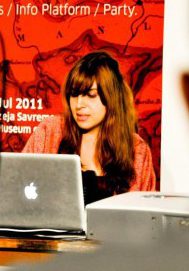Laura Plana Gracia
Laura P. Gracia
MPhil Student
2016 - current
Laura P.Gracia (Barcelona, 1982). Curator, artist, and researcher, currently an MPhil student at CRiSAP, UAL, where she studies the new tendencies in curatorial practices and cultural management in sonic arts. In 2006, she graduated in History of Art (University of Barcelona). Consequently, studies at Master in Cultural Practices and New Media Art (University Ramon Llull). In 2009, establishes in London where attends to Curating course (Central Saint Martins, UAL). One year after, she was granted to study at MAH Media Art Histories (Donau University, Krems, Austria). In 2011, attends the professional course about New Media Curating, led by Beryl Graham (University of Sunderland). Interested in sound art, science, technology and digital media, she is an active participant in hacking culture. Over these years, as a curator, she has taken part in many international events such as exhibitions, workshops, conferences, publications, and concerts in Spain, UK, Mexico, Colombia, Canada, Serbia, Russia, Hong Kong, the U.S., and Brasil. Among the collaborations, she developed projects with various institutions such as Fonoteca Nacional de Mexico, MACBA Museum of Contemporary Art Barcelona, CCCB Centre of Contemporary Culture Barcelona, MOTA Museum of Transitory Art, ISEA International Symposium on Electronic Arts. She has worked with the following new media festivals, ArtFutura, MUTEK, Alpha-ville. She collaborates with artists such as Locus Sonus, Scanner, Roy Ascott, Konrad Becker, Fran Illich, Milo Taylor, and Arcangelo Constantini, among much more. One of the future activities which support her practice-based research is the exhibition “Sounding D.i.Y.” (various venues, London, 2017).

PhD
Curating Sound Art: Defining new strategies for the public exhibition of sound art.
The aims of the research lie on the proposal for a strategy in the curating sound art. Even sound art could have existed before and has been presented in festivals and concert halls; it is not yet until 1960 when is inserted in the museum. As Jose Iges states in the curatorial text of the exhibition “Sound Art in Spain (1961-2016)”, “the entry of so-called "sound art" in museums has led to the entry of a novelty in spaces that had remained more or less unchanged -in visual terms- almost until the 60s of last century”. However, institutions are still influenced by the curatorial Occidental methodology considering visual aspect of culture, rather than hearing phenomena. The research proposes an investigation that will study contemporary art theories of Hans Ulrich Obrist (A Brief History of New Music) who introduces a more procedural aspect in the definition of curating sound art influenced by music. The research will also contribute to developing curating sound art by theories of curating new media, questioning the technological aspects of sound. The theoretical framework of curators Beryl Graham and Joasia Krysa will contribute to a new dimension of curating sound art with concepts such interaction, process, and participation. Moreover, the project proposes to do research on the John Cage’s work presented at E.A.T. Experiments in Art and Technology, Armory Show, New York, 1966 as a model for curating sound art and as an example of collaborative practice among sound art, electronic art, and new media art.
Supervisors
Social media
IRC Channel: netzzz
Contact
laura@netzzz.net
